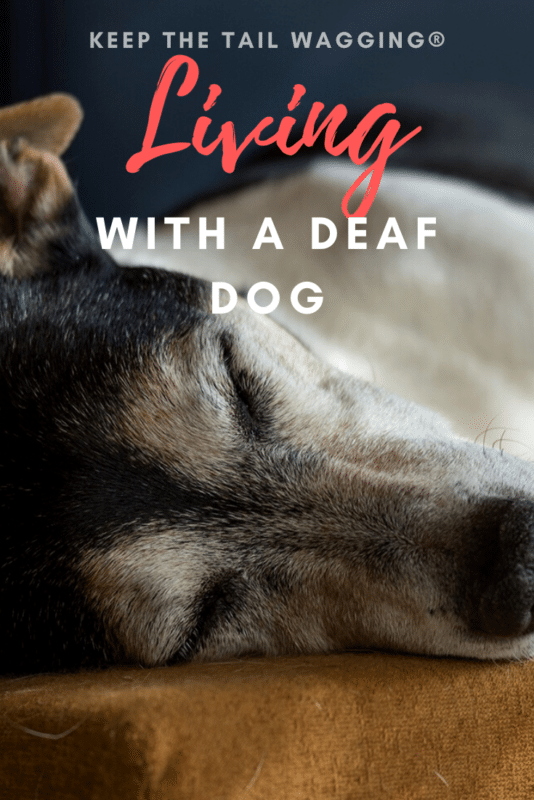Keep the Tail Wagging is supported by pet parents. I occasionally earn a commission (at no additional cost to you) when you click through an affiliate link to one of my favorite products. Thank you for your support. Read More
This blog post was originally published in November 2012. It has been updated with new information and helpful videos for pet parents raising deaf dogs. With two of our dogs becoming seniors, the idea that they could lose their hearing made me want to look more into what life with a deaf dog would be like for us.
I'm terrible about keeping up with the pet holidays. Deaf Pet Awareness Week is in September and I'm updating this blog post in May. Better late than never? When I originally wrote this blog post, it was out of curiosity about what it's like to raise a deaf dog. Over the past eight years, I've met several pet parents raising deaf dogs and realize that the loss of hearing is something a dog and their human can adapt to and overcome in many ways to lead a long, fruitful life.
What Causes a Dog to Go Deaf
In my research, I found that some dogs are born deaf. A dog can go deaf after prolonged and chronic ear infections. Deafness can come about from an injury or simply from old age. Most of the puppies and young dogs that are deaf and/or blind that I see are a Double Merle, which means that they are a product of breeding two Merles together. Sadly, many of these dogs are dumped or killed because they aren't valuable. And that's sad because like hearing dogs, they can live full, active, happy lives.
Signs that Your Dog is Losing their Hearing
There are many signs that a dog is losing their hearing beyond not hearing us when we call. If you notice a few of the following habits occurring with your dog, call your veterinarian to ask about the options available to test your dog.
- not responding to their name being called
- not following commands because they can't quite hear you
- not barking at things that used to trigger your dog (like someone walking onto the porch)
- a change in personality
- shaking their head or tilting their head to one side; like a dog does when they get water in their ear after swimming
- sleeping deeper, harder to wake up
- painful or smelly ears due to a serious ear infection
If you suspect that your dog is losing their hearing, you can test it out by making a noise behind them (not right behind them) to see if they react.
Myths About Raising Deaf Dogs
Myth #1 – Deaf Dogs are Harder to Train
While I appreciate that someone wants a perfect puppy when they go to the shelter, a deaf dog shouldn't be written off the list. While training may not be conventional, it's not impossible. Instead of verbal commands, pet parents use hand signals and other tools that a dog can understand. Remember, dogs are smart and they adapt well.
Myth #2 – Deaf Dogs Can't Do Things Hearing Dogs Can
I'm sure that there are things a hearing dog can do that a deaf dog can't, like hear their name called. However, while doing the research for this blog post, I was astounded by what a deaf dog can do and loved watching the agility videos.
Waking Up with a Deaf Dog
- Some deaf dogs sleep longer and more deeply than hearing dogs; so it’s paramount to wake your dog gently (especially new puppies).
- Take the time to get your dog's attention by waving your hands in front of their nose (gently) until they can smell you and wake up on their own or you can gently touch them to wake them.
- Another great way to get your deaf dog’s attention is by appealing to their sense of smell; use a yummy smelling treat to gently awaken them or gain their attention.
- Jarring them awake will frighten them and you risk being bitten.
Communicating with a Deaf Dog
I love watching people communicating with their deaf dog because it's such an amazing reminder that dogs are amazing creatures, the bond behind a deaf dog and their human is so clear, and there is so much all of us can learn. When it comes to “talking” to a deaf dog, many pet parents use ASL (American Sign Language) and some make up their own hand signals that their dog comprehends. However you choose to communicate with your dog, it's important to be consistent – don't change the sign for “sit” every other day.
In this video, Christina Lee shares common signs she uses with her dogs.
Training a Deaf Dog
Learn and master hand signals and commands and be sure that you trust your use of them before allowing your deaf dog off-leash because they won’t hear you calling their name. There are vibration collars (these do not deliver a shock) that you can use when training your deaf dog or to gain your dog's attention.
The following is a playlist that I found on YouTube that offers training tips for pet parents raising deaf dogs.
More Tips About Raising a Deaf Dog
Walking with your deaf dog: some deaf dogs can hear very different pitches and dog owners won’t know which ones they can hear until in the moment. Hearing these sounds may startle your dog, leading your dog to run away. Also, a deaf dog may not hear a vehicle approaching. It's best to keep your dog on a leash unless you're in a secure, fenced-in area to keep your dog safe.
Let your dog know that you're leaving: imagine your dog waking up and realizing that you're gone. This may be okay for some dogs, but I can imagine that it can be jarring for a dog that is adapting to a new home or life without hearing. If your dog is sleeping, gentle wake him or her up to let them know that you're leaving or seek out your dog to let them know.
Keep tabs on your dog: keep doors closed so that you don't inadvertently lock your dog in a room or outside. I've locked Scout (he's not deaf) in the garage so many times and I feel like a monster each time. He doesn't bark to come in, but after about an hour, he'll start whining. It's easy to become distracted and leave a door open while you run inside or outside to grab something – take the extra second to shut the door.
It's important to remember that if your dog gets out and is trotting down the road, they may not hear you when you call their name. And, just in case your dog does get out, consider adding tags with your contact information to your dog's collar and a bell so that you can find your dog.
The following video shares how to teach a deaf dog “come.”
Unique Opportunity Provided by Raising a Deaf Dog
Although Cesar Millan is polarizing in the pet lover community, I have found that he can be insightful on the topic of dogs. I found this message when I was doing research for this post and it touched me in a way that made me want to hug our dogs for hours. This is beautiful.
A person with a deaf dog has a unique opportunity to communicate with their dog as the animal they are. Dogs communicate through energy and body language. I’ve said many times that you don’t get the dog you want, you get the dog you need. I’ve seen it time and time again that the dog a person chooses comes into their life and teaches them the lessons they need most.
So what are the lessons a deaf dog can teach? So many humans are out of touch with Mother Nature. They’ve lost patience. They’re disconnected from their lives. They are not mindfully aware and emotionally in tune. With a deaf dog, it is critical that you be present, feel the energy, read signals, and be in tune to yourself and the environment around you, just as you are asking your dog to do. You will need to bond with your dog in a way that he trusts you as his leader; a leader whose job is to provide him with protection and direction. So if you are going to cross the street, he looks to you to keep him safe. If you are turning the corner, he looks to you to show him which way to go.
~ Cesar Milan
Deaf Dog Community
If you have a deaf dog or are considering adopting a deaf dog, there is a community that offers information, training, and support. I thought Deaf Dogs Rock was just a blog about deaf dogs, but spending a short amount of time on the website will show you that it's much more. If you have any questions about raising a deaf dog, I highly encourage you to check out the community.
Read More About Raising Dogs
- Is Wondercide Still Safe for Dogs to Repel Fleas and Ticks?
- Books to Help Dog Owners Feed Their Dog Better
- 3 Reasons Why Dogs Put Their Paw on Their Owner
- The Ultimate Guide to Choosing the Perfect Stuffed Dog Toys
- Is it Possible to Prevent Littermate Syndrome in Puppies?


















What a wonderful article! I highly appreciate that! Thank you for sharing
My dog is 14 yrs. old had gotten diabetes abt six months ago. He got cataracts in both eyes and Partial hearing loss of hearing. 3 months later I had his cataracts removed. It was expensive but Worth every Penney. He responds to my whistle. He is back to his old self again. They also have hearing aids for dogs.
I adopted a Yorkie puppy deaf from birth, the first day I met him he bit his owner, and was literally hanging by two teeth from her thumb! I didn’t take him home that day, I had to think on it some more he was a handful I could see. But, I brought him home and he has ended up being the most wonderful pup I’ve ever owned! He is ALWAYS tuned into Mom, seems ever present with us. He’s definitely not like a hearing dog! I’ve never had a dog want to be touched, or just be next to me the way he is. He doesn’t even nap that he’s not on my hip. It’s taken a TON of patience and love, but he’s changed my mind about non hearing dogs..I wouldn’t trade him for a million dollars!
Hi Stephanie…I recommend working with a professional dog trainer who is experienced with deaf dogs and puppies.
Hi we have a Catullua puppy she is deaf . She is aggressive at times like putting on her harness and like if u wake her up could anyone help us out any ideals
I just adopted a 10-year-old dog who was noted as blind. Turns out he is also deaf. I’ve had a deaf dog and a blind dog but never one with both impairments. At first thought this would be more than I could handle but it turns out he can learn as my other impaired dogs did. Go slowly and give treats often; be consistent in patterns of paths through your house and yard; take walks outdoors slowly so the dog can accustom itself to the route you follow and the textures of the pathways you follow. Give touch rewards often and lavishly. Talk to the dog as if it could hear–that keeps you tuned into the dog even if the dog can’t hear you. He/she needs to know you are there and that you are in charge and that he/she can trust you. I guide my dog up and down stairs and through the dog door until he can do them on his own but always with me at his side. Make sure the environment is safe. Give him a safe place to rest that is his own, even if you have other dogs. Have faith and take your time. Think positive. The dogs have taught me that they are far more capable of achieving than we give them or ourselves credit for being capable of!
Thanks for sharing, Kyle – that’s so nice to hear. I would love to adopt a deaf dog and when Keep the Tail Wagging is a full time gig, that’s just what we’ll do!
Kimberly
I just began volunteering at Angel Dogs Deaf Dog Ranch in Acton, CA. The dogs there are rescues. They are taught hand signals. They become available for adoption in time. I adore deaf dogs! So wonderful to bond with! So trusting. Best dogs ever!
I’ve been teaching our dogs hand signals too. It isn’t something that I connected with them going deaf; but after having learned more about raising a deaf dog, I’m glad that I’ve taken the extra steps. My original goal was to be able to tell them to do things quietly. Now I have a bigger goal.
My friends have a double dapple Dachshund that was born deaf. I have learned a lot from them about living with a dog that can’t hear you. We take them being able to hear them for granted. Chester and Gretel DO know hand signals for sit and stay. Chester is 10 so that will help us if he starts to lose his hearing.
I love the idea of adopting a deaf dog. In a few years we’ll be ready for our 4th. It’ll be interesting to know if you’re idea would help.
Great article. Some time back we were actually discussing the possibility of using the vibrate function on the E-collars; kind of as a tap on the shoulder replacement. Curious if that would be helpful.